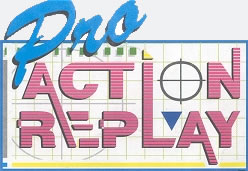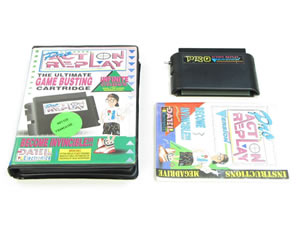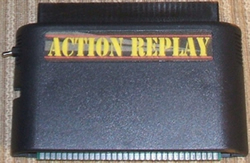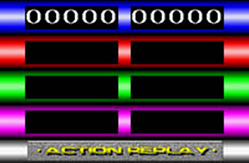Cheating devices have been around almost since there was electronic gaming. For the Sega Genesis, most North American gamers recall the Game Genie distributed in the U.S. by Galoob (and actually developed by the British-based company Codemasters). This handy little cartridge was used as a pass-through between the game of your choice and the console and allowed modifying the game code in order to achieve effects that usually made the gaming life easier, like unlimited energy or starting with many more extra lives.
 However, there was another device that was in direct competition with the wish-fulfilling little cheater. Also based in Britain, independent hardware manufacturer Datel pushed its own series of lock-on game manipulation devices that still exists for consoles up until today: the Action-Replay line of modules. What few people remember is that there were not one, not two, but actually three (technically four) different revisions of this device released. And even less remembered is the fact that while the original Action Replay for Mega Drive and Genesis has basically the same functionality as the Game Genie, the two Pro revisions tack on several nifty extra features that make the cart even more desirable.
However, there was another device that was in direct competition with the wish-fulfilling little cheater. Also based in Britain, independent hardware manufacturer Datel pushed its own series of lock-on game manipulation devices that still exists for consoles up until today: the Action-Replay line of modules. What few people remember is that there were not one, not two, but actually three (technically four) different revisions of this device released. And even less remembered is the fact that while the original Action Replay for Mega Drive and Genesis has basically the same functionality as the Game Genie, the two Pro revisions tack on several nifty extra features that make the cart even more desirable.
A Little Bit of History
Datel hadn’t just released the Action Replay as a knock-off following up on the success of the Game Genie. The series of modules had actually been around since 1983, though not for video game consoles. Still, as cheating devices for video game consoles, Codemasters and Datel were quite fierce competitors. As the story goes, when Codemasters tried to protect its Game Genie by filing a patent for cartridge-based game manipulation devices, Datel countered that attempt by stating: “We’ve been cheating at games since long before the Game Genie existed!” However, while the Game Genie was a product officially licensed by SEGA, the Action Replay didn’t get to wear this seal, which may have been due to the company’s reputation at the time.
The Action-Replay-line originally saw its birth on the Commodore 64 home computers. While the video game crash of 1983 left the North American console scene floundering, the European home computer market was booming. Developers like Atari, Commodore, Texas Instruments, Sinclair, or Amstrad all developed their own home platforms. The Commodore 64 in particular, first introduced in 1982, proved to be quite the smash hit across Central and Western Europe. Not only did the computer sport some advantages over the competition, like the then-novel sound chip and a whopping 64kb of RAM, like many of its competitors it also allowed for expansions over a built-in cartridge slot. Originally thought of as a means to allow for more memory or an easy way to instantly start programs and games (disk and tape drives had to be bought separately for the C64, so the cartridge slot was the only way to actually do something with their computers besides stare at a blue screen), some inventive developers soon found new ways to enhance, but also to tamper with the machine and the software it ran. One of these fellows was Richard Bond, who designed the first Action Replay.
Datel had already been around a few years as a developer of third-party hardware and interfaces for several home computers, but the Action Replay for the C64 proved to be its first big hit. Basically, the device, once plugged into the expansion port, allowed users to create snapshots of the Commodore´s memory and dump them on either disk or tape. Also, handy Peek and Poke commands could be executed while a program was currently running and could be enabled or disabled over a handy “FREEZE” button. This enabled a player, for example, to set the number of lives one had in a game to a fixed state and “freeze” them in place, so to speak. This function proved to be extremely popular, and many computer magazines in Europe in return started to publish so-called “freeze codes” or “freeze addresses” in their hint sections due to the popularity of the device. Over time, the Action replay saw several revisions and received new, additional features. The sprite monitor allowed modifying sprite graphics and could enable or disable the collision detection, basically making the player invincible. The hardware monitor made directly manipulating game code far easier, and later revisions also had a fastload option that made the C64’s notoriously slow load times a little more bearable.
While the C64s Action Replay was generally well received as a cheating module, it also gained quite an infamous reputation due to its ROM dump functionality. Using the cart it was very easy to simply “dump” a tape or disk to another drive and create a copy of a game, often even circumventing copy protection measures in the process. You could even dump “enhanced” code and create a copy of the game where the player had, for example, additional lives. Needless to say, Datel came under a lot of fire, and its devices for the C64 and the Commodore Amiga were often blamed for hurting the still fledgling (in Europe) game industry. The company reportedly sold hundreds of thousands ARP devices, and if each device sold had copied at least ten games, the damage to program developers would range into the millions. For that and similar reasons, the “Copyright Law of the United Kingdom” was accordingly amended in 1988. The so-called “Copyright, Designs and Patents Act of 1988” was directed precisely against this particular manner of copying software. Other countries followed suit. However, many critics forget that the devices were also very popular among programmers, since they were a simple means to easily and quickly access the full potential the machine had to offer and sped up development.
While the original Action Replay achieved the height of its popularity in the late ‘80s, Datel began to struggle due to the aforementioned legislative act but also because the home computer market in general entered a slump when the 1990s rolled around. In order to stay relevant, the company had to expand its market to other platforms. Thus, the Action Replay was brought to the 8 and 16-bit consoles, which, with a few years’ delay after the North American market, were just having their big comeback in Europe.
“Freezing” the Mega Drive
While Codemasters certainly was first when game manipulation devices for the NES are concerned, it is hard to tell which cheating cartridge was first released for the Mega Drive. The ROM of the Action Replay bears a 1991 copyright date, which would suggest a released date in late 1991, early 1992 and thus slightly before or at least roughly around the same time the Game Genie hit the Genesis.Whatever the case, the first iteration of the Mega Drive version of the Action replay is remarkably similar to the Game Genie. Both cartridges have a switch that allows toggling the device on and off, which can be handy at time. Some games might freeze if a certain cheat code is active after a specific point in the game, or a gamer might just have limited invulnerability and continue on his own later on. Also, similar to the Game Genie, it might happen that your game freezes up if you toggle the switch too often.
The first, most visible difference to the Game Genie is that the Action Replay doesn’t use the somewhat coded 8-digit integer values. Instead, codes are entered in the form of hex addresses, which is a more easily interpreted way of reading the game code. As such, it is easier to pinpoint the exact place and manner in which a cheat is implemented. If a certain hex-code is entered, the value that is found under the given address is basically frozen in place, so if you know under which hex address a game saves the number of lives, “freezing” this number basically means an unlimited amount of lives.
It didn’t take long for gamers to realize that this manner of code manipulation meant another big advantage: Hex codes could be used to bypass regional lockout as well. The values for which region a cart is meant to be played can usually be found at a certain address in the game’s code. Replacing and freezing this address with a different value would change the region as well. This manner of using the Action Replay as an import module worked the same way as the Game Genie. Again, game magazines used to print many of these “freezer addresses” in their cheats and tips sections.
However, there was a hitch. In order to make a game region-free, you usually needed to freeze at least two, sometimes even three addresses. For example, to enable the Japanese version of Mega Man: The Wily Wars for play on PAL Mega Drives, you needed to fix the addresses 00018: EAD23, 0001F: 04520 and 00036: A4E71 in place. Also, some developers tried to prevent such manipulations. For some games, players needed to enter so-called master keys, or the game would freeze up otherwise. The first Action Replay allowed a maximum of four codes to be entered, barely enough (and on rare occasions insufficient) if you needed both a master and an import key.
The biggest downside of this device though was also that, just like with the Game Genie, you never really knew what a code did unless you tried it. If you entered the wrong code, the game would glitch up or freeze. Luckily game publications provided hundreds of valid codes, ranging from color manipulation to absolute invincibility. If you wanted to create cheat codes on your own with this device though, all you could do was guess wildly.
Going Pro
 To rectify this, Datel revised the device and in 1992 released a new version called the “Action Replay Pro Version,” which was later superseded and simply called “Pro Action Replay.” As the name suggests, this was an enhanced version of the original device. The most visible difference between the AR Pro Version and the PAR is a slightly different menu design, but basically both devices are pretty much the same. The number of codes entered simultaneously was raised from four to 20, and as a neat extra the box also included a little booklet containing hundreds of already existing codes from the Genesis library of games. But that was not the most important change. On top of that, the Pro Version now had an implemented trainer and game code search mode, which allowed looking for and creating your own cheats, given some time and patience. For that, the switch on the cart now had three positions: “trainer” (down), “off” (middle) and “on” (up). You had the options of looking for “lives or other number,” “timer or similar,” “energy bar or similar” and “change of status.”
To rectify this, Datel revised the device and in 1992 released a new version called the “Action Replay Pro Version,” which was later superseded and simply called “Pro Action Replay.” As the name suggests, this was an enhanced version of the original device. The most visible difference between the AR Pro Version and the PAR is a slightly different menu design, but basically both devices are pretty much the same. The number of codes entered simultaneously was raised from four to 20, and as a neat extra the box also included a little booklet containing hundreds of already existing codes from the Genesis library of games. But that was not the most important change. On top of that, the Pro Version now had an implemented trainer and game code search mode, which allowed looking for and creating your own cheats, given some time and patience. For that, the switch on the cart now had three positions: “trainer” (down), “off” (middle) and “on” (up). You had the options of looking for “lives or other number,” “timer or similar,” “energy bar or similar” and “change of status.”
Here’s a short breakdown of how the process worked. Say you wanted to search for where a game saves its number of lives. First, you plugged the game into the PAR cart and inserted both into your Mega Drive. Then, you flipped the switch down (trainer position) and started the game, so you could see the number of lives. Immediately hitting reset would bring you back to the menu of the Action Replay. Under the section “start trainer – lives or other number,” one would now set the number of lives the game had presented up to that point (three in case of Sonic The Hedgehog, for example) and choose “exit to game” afterwards. Now, you started a new game but immediately lost a life. After the counter went down, hit reset again, then choose “continue with trainer” from the menu. If you now reduced the number of lives by one (for example, from three to two), the trainer would now list all instances where in the game a value of three had been replaced with a value of two. Since that would usually result in hundreds of codes, one would then repeat the process, sometimes losing more lives, sometimes none at all, and always searching for a corresponding change in the trainer afterwards. Eventually, one would whittle down the number of possible addresses to a handful of codes (between eight or twenty). Now you would just try out these addresses one after another, one of them then usually would give you unlimited lives. Like I said, it takes a little patience, but back in the day it was very satisfying to finally have a method of passing those incredibly hard games and being able to create your very own cheats. When I was fifteen I had used that feature to discern how to get unlimited energy in Mortal Kombat 3. It took me about 15 minutes, but when I had finally found the codes out I felt so very, very smug.
From Small-Time Cheat to Big-Time Importer
In 1994, Datel would eventually release the final, definite version and the most versatile cheating module for the Mega Drive in existence, the Pro Action Replay 2. Again raising the number of simultaneous codes up to a whopping 100, the PAR2 now also included all the codes that had previously been printed in the Pro Action Replay booklet in the cart’s ROM itself and could be selected directly, saving the hassle of entering several ten-digit codes by hand. Most importantly however, the cart was now able to function as an import cartridge without any need of freezer addresses at all! By going to the so-called option screen, players now could select the cartridge type and thus, for example, force a PAL console to accept a Japanese cart even if said game was region locked.
Unfortunately, Datel had only optimized the import option of its cart for the European market. If plugged into an American NTSC Genesis, users would find the selection “use PAL cartridge” missing from the menu. While importing Japanese games to a Genesis would still work fine, the handful of region locked PAL titles like Alien Soldier would still remain unavailable for American gamers without a hardware mod or a Mega Key device. Using region-locked Japanese games is still possible however, so you’re not missing out on much.
Top of the Line
There’s also another tiny flaw that all iterations of the Action Replay share with the Game Genie. On some games that use memory saves, the cart may occasionally wipe all save states. It happened to me when using the module to play an NTSC copy of Landstalker on my PAL Mega Drive, and I wasn’t even using any cheat codes at the time but just the import functionality. Needless to say, it was a very frustrating experience.
Other than that though, the Pro Action Replay 2 is an awesome little device. While the Game Genie would eventually vanish from the console market, Datel was still continuing its Action Replay line up until the sixth console generation (in the U.S., Action Replay devices would sometimes be found under the Game Shark imprint). So far, latest in the lineup was the Action Replay DSi released in 2009.
Nowadays, it seems like the Game Genie is better remembered as the prime 16-bit cheating device instead of the Action Replay. But that’s mostly due to the fact that while Codemasters and Galoob could secure an official license by Sega, Datel didn’t, which gave the Game Genie an advantage in advertising and a huge boost in general popularity. And yes, the basic Action Replay, with just four lines of cheat codes and no trainer or import features, was very lackluster and didn’t achieve much by comparison. The Pro versions, however, and particularly the PAR2, were immensely superior and leave very little to be desired, particularly for owners of a PAL Mega Drive. If you go hunting for a cart of your own, make absolutely sure to get the Pro Action Replay 2 (in the RED box) if you also want to have the import function included into the module. It should take you down no more than 30-40 Euros (40–55$ US) without shipping. Be extra careful, however. Sometimes sellers try to trick you by selling the Pro Action Replay (white box) and labeling it something among the lines of “Action Replay v2.” Be extra careful that it says Pro Action Replay 2 on the cart itself.
If you’re looking for PAR codes on the Internet, CheatZilla and BSFree host a pretty good selection, though whether the codes posted there actually work may not be guaranteed. On Sega Kore you can also find an online converter that changes Game Genie codes into Action Replay and hex addresses and vice versa. Last but not least, Tony Hedstrom (who also frequents the Sega-16-forums under the handle TonyH) hosts a great, 100% working selection of both old and new freezer codes over at his Website “The Code Hut“, along with a handful of nifty guides that teach you how to find and create new cheat codes more efficiently.





Recent Comments